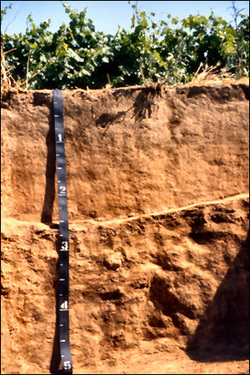Soil Composition
General:
The soil in the chaparral is very nutrient poor. This leaves the soil nutrient poor and vulnerable to erosion. Once the soil is eroded away, either by wind or rain, the ground under the soil is usually bare rock, very thin, or clay. It takes a long time for fertile soil to form, and even longer for forests to grow back. Chaparral, however, can grow in this desert-like soil when most plants cannot. Chaparral plants take over and dominate these spaces before anything else can grow.
Types of Soil:
The first layer is serpentine which has elements of magnesium, nickel, and chromium, which are usually toxic to plants. However, the plants that thrive at the chaparral actually are more shrubs and less grassland native species. The second layer is non- serpentine sedimentary soil, this was formed from sedimentary parent rock. This layer is high in calcium but is not necessarily high in nutrients. The third layer is vernal pools, it is a shallow body of water that sometimes occurs when the rain during the winter season has been plentiful. The fourth layer is gabbro which is an igneous rock layer. This layer is once again nutrient poor, but contains high levels of iron and sometimes chromium. A layer which is found only near rivers and streams is the alluvial soil layer. Is is high in organic material and can support a thick forest of oak trees.
Producer Survival:
The plants that exist in the Chaparral biome are mainly composed of shrubs, dwarf trees, and grasses. They are drought tolerant with root systems designed to absorb as much water as possible from the soil. Many of the plants are pyrophyte (fire-loving) plants, with seeds that will only germinate in the presence of a fire. The soil of the California Chaparral region supports producers that tolerate and thrive on few nutrients, therefore to retain the water that they get and also to become an unattractive dining choice to animals, the plants have a waxy coating the their leaves and stems.
The soil in the chaparral is very nutrient poor. This leaves the soil nutrient poor and vulnerable to erosion. Once the soil is eroded away, either by wind or rain, the ground under the soil is usually bare rock, very thin, or clay. It takes a long time for fertile soil to form, and even longer for forests to grow back. Chaparral, however, can grow in this desert-like soil when most plants cannot. Chaparral plants take over and dominate these spaces before anything else can grow.
Types of Soil:
The first layer is serpentine which has elements of magnesium, nickel, and chromium, which are usually toxic to plants. However, the plants that thrive at the chaparral actually are more shrubs and less grassland native species. The second layer is non- serpentine sedimentary soil, this was formed from sedimentary parent rock. This layer is high in calcium but is not necessarily high in nutrients. The third layer is vernal pools, it is a shallow body of water that sometimes occurs when the rain during the winter season has been plentiful. The fourth layer is gabbro which is an igneous rock layer. This layer is once again nutrient poor, but contains high levels of iron and sometimes chromium. A layer which is found only near rivers and streams is the alluvial soil layer. Is is high in organic material and can support a thick forest of oak trees.
Producer Survival:
The plants that exist in the Chaparral biome are mainly composed of shrubs, dwarf trees, and grasses. They are drought tolerant with root systems designed to absorb as much water as possible from the soil. Many of the plants are pyrophyte (fire-loving) plants, with seeds that will only germinate in the presence of a fire. The soil of the California Chaparral region supports producers that tolerate and thrive on few nutrients, therefore to retain the water that they get and also to become an unattractive dining choice to animals, the plants have a waxy coating the their leaves and stems.

